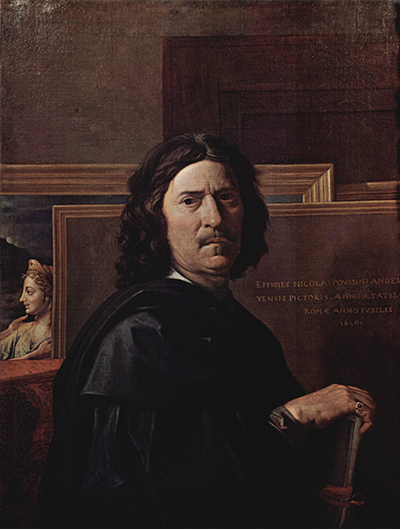Nicolas Poussin was a complicated man with decisive ideas about art and painting: he loathed the studio system in which all the house artists would help to complete large commissions, with the quicker workers scoring themselves a bigger piece of the canvas, and he detested Caravaggio's work, saying he (Caravaggio) was destined to 'ruin painting'.
He preferred to work in his unique style, which developed discernibly over the years as he moved in and out of the influence of various artists, from Varin in his youth, to Ferdinand Elle and Georges Lallemand (from where he learned his distaste for the paint-by-numbers type of work of studio pieces) to, finally making it to Rome in 1624, following two previous attempts over the eight years before, Simon Vouet as well as prestigious artists from earlier times such as Raphael and many others.
Poussin, unlike many of his contemporaries, did not paint modern scenes as a rule. His heart and head were in the worlds of fable and myth, where Greek gods and goddesses, Biblical tales, and legends and folk tales were merged into fantastical and yet realistic tableaux on canvas. His one exception was his occasional self-portraits, in which he has managed to capture his own intense concentration on the subject at hand. Unlike many artists who strove for a 'snap-shot' effect, showing their own reflection in a mirror, complete with easel and palette laden with vibrant paints, Poussin has worked this Self Portrait in a slightly different manner.
It is clearly a self-portrait, given the intensely focused gaze – which can be slightly disconcerting to the unwary viewer: one wants almost to murmur an apology for disturbing him! – and yet he holds in his hand a scroll or a book, bound with a red ribbon, his hand positioned in such a way to show the decorative stone on the ring that sits on his baby finger. The design would have been instantly recognisable to his colleagues and those whom he sought to impress, a subtle signal that would appear only to those to whom it mattered – like much of the symbolism in his narrative paintings!
Poussin is formally dressed, as he would be for a meeting or to be seen in public, with a black cape thrown back over his shoulders to reveal a black long-sleeved tunic or robe. The effect is imposing and authoritative, as is his severe expression. Behind him appear to be a stack of painted canvases, with only a single striking female profile discernible in the images. This figure is wearing a coronet which features the unusual design of an eye: perhaps a statement of pride: art is the king, and she is the muse of vision that allows artists to fulfil their destinies? The painting can be viewed in the Musee de Louvre in Paris, but it is fairly small, measuring a mere 98cm by 74cm in oil on canvas. If possible, see if you can discern the text that appears behind the artist, on the right-hand side – a warning though, it is in Latin!




